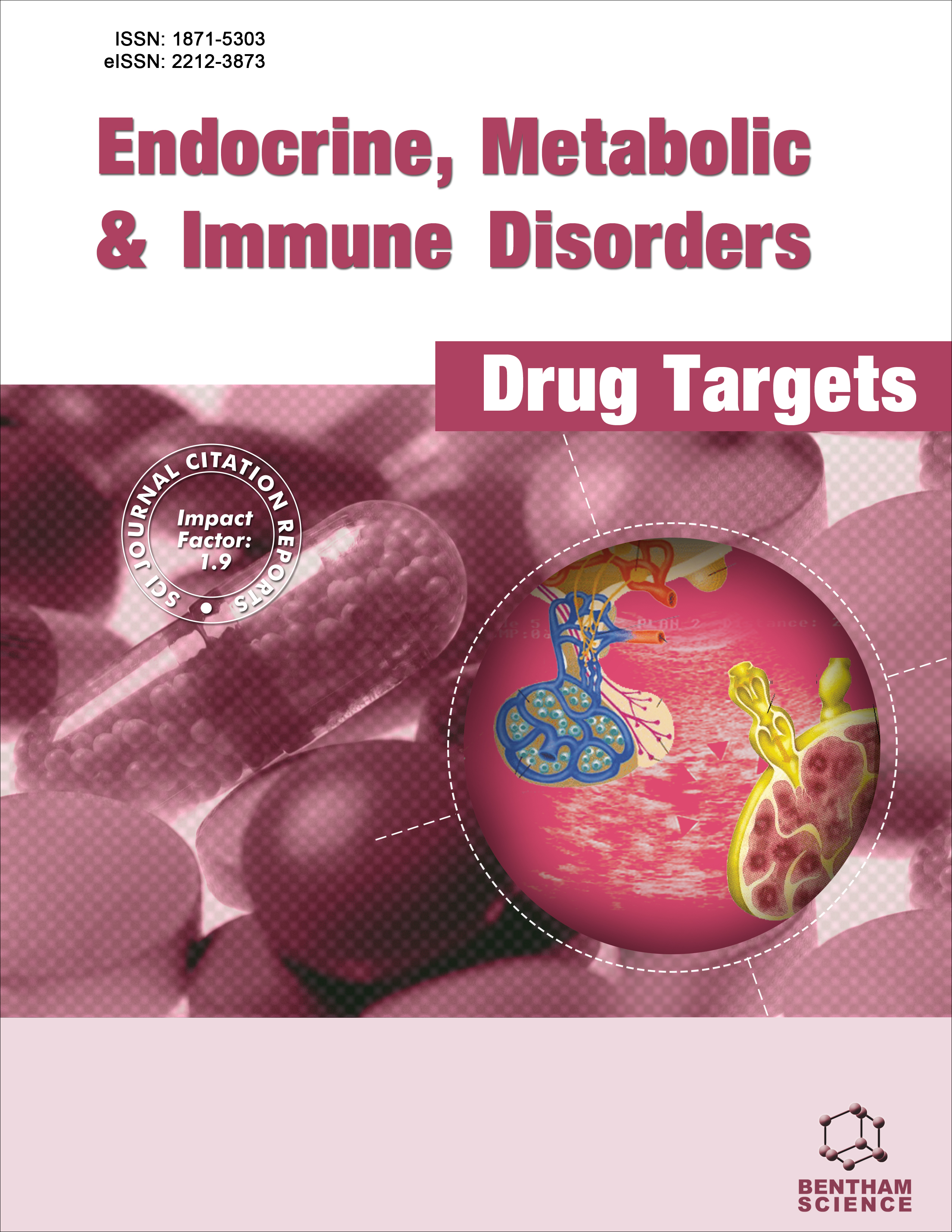- Home
- A-Z Publications
- Endocrine, Metabolic & Immune Disorders-Drug Targets (Formerly Current Drug Targets - Immune, Endocrine & Metabolic Disorders)
- Previous Issues
- Volume 9, Issue 2, 2009
Endocrine, Metabolic & Immune Disorders-Drug Targets (Formerly Current Drug Targets - Immune, Endocrine & Metabolic Disorders) - Volume 9, Issue 2, 2009
Volume 9, Issue 2, 2009
-
-
Retinoids as Critical Modulators of Immune Functions: New Therapeutic Perspectives for Old Compounds
More LessAuthors: Michele Montrone, Debora Martorelli, Antonio Rosato and Riccardo DolcettiRetinoids are vitamin A derivatives that critically regulate several physiological and pathological processes, including immune functions and cancer development. These biological response modifiers exert their pleiotropic effects through the interaction with nuclear receptors, defined as retinoic acid receptors (RARs) and retinoid X receptors (RXRs). These ligand-activated nuclear receptors induce the transcription of target genes Read More
-
-
-
T-Lymphocytes: A Target for Stimulatory and Inhibitory Effects of Zinc Ions
More LessAuthors: Andrea Honscheid, Lothar Rink and Hajo HaaseThe trace element zinc is a crucial cofactor for many proteins involved in cellular processes like differentiation, proliferation and apoptosis. Zinc homeostasis is tightly regulated and disturbance of this homeostasis due to genetic defects, zinc deficiency, or supplementation influences the development and the progression of various infectious and autoimmune diseases. The immune system is strongly impaired during zinc d Read More
-
-
-
The AKT Axis as a Therapeutic Target in Autoimmune Diseases
More LessAuthors: Tianfu Wu and Chandra MohanAutoimmunity affects a substantial fraction of our population. In patients with autoimmune disease, the immune system recognizes self-tissues as foreign. Common autoimmune diseases include rheumatoid arthritis, diabetes mellitus, lupus and multiple sclerosis. Though different target organs may be affected in different autoimmune diseases, aberrations in adaptive or innate immunity underlie all of these diseases. Abnormal f Read More
-
-
-
Targeting Indoleamine 2,3-dioxygenase (IDO) to Counteract Tumour- Induced ImmuneDysfunction: From Biochemistry to Clinical Development
More LessAuthors: S. Rutella, G. Bonanno and R. De CristofaroThe enzyme indoleamine 2,3-dioxygenase (IDO) regulates immune responses through the capacity to degrade the essential amino acid tryptophan into kynurenine and other downstream metabolites that suppress effector T-cell function and favour the differentiation of regulatory T cells. Considerable experimental evidence indicates that IDO can be expressed by dendritic cells, by tumour cells or by surrounding stromal c Read More
-
-
-
Impact of IL-17 on Cells of the Monocyte Lineage in Health and Disease
More LessAuthors: S. Sergejeva and A. LindenDiscovered in 1993, IL-17 has been the focus of intensive research during the last decade, in particular because of its neutrophil-accumulating capacity in several mammalian organs. We now know that the IL-17 family includes as a minimum 6 members, of whom at least IL-17A and IL-17F can be produced by T cells. Thus, IL-17 is positioned at the interface of acquired and innate immunity and constitutes a link between T c Read More
-
-
-
Dissecting Insulin Signaling Pathways: Individualised Therapeutic Targets for Diagnosis and Treatment of Insulin Resistant States
More LessAuthors: Yvonne L. Woods, John R. Petrie and Calum SutherlandLife expectancy in the developed world is increasing, but this comes with a simultaneous explosion in ‘agerelated’ as well as ‘lifestyle-related’ diseases, resulting in a decline in quality of life. Three such diseases are Type 2 diabetes mellitus (T2DM), Polycystic Ovarian Syndrome (PCOS) and non-alcoholic fatty liver disease (NAFLD), which all share a common reduced cellular response to the hormone insulin (termed insulin re Read More
-
-
-
Inflammatory Bowel Disease and Celiac Disease: Overlaps in the Pathology and Genetics, and their Potential Drug Targets
More LessInflammatory bowel disease, which covers Crohn's disease and ulcerative colitis, and celiac disease are both inflammatory diseases of the intestinal tract. In both diseases an antigen activates several inflammatory pathways, which cause extensive damage to the intestinal mucosa and lead to increased permeability of the intestinal epithelium. The causative antigen in inflammatory bowel disease is the microflora in the intestin Read More
-
Volumes & issues
-
Volume 25 (2025)
-
Volume 24 (2024)
-
Volume 23 (2023)
-
Volume 22 (2022)
-
Volume 21 (2021)
-
Volume 20 (2020)
-
Volume 19 (2019)
-
Volume 18 (2018)
-
Volume 17 (2017)
-
Volume 16 (2016)
-
Volume 15 (2015)
-
Volume 14 (2014)
-
Volume 13 (2013)
-
Volume 12 (2012)
-
Volume 11 (2011)
-
Volume 10 (2010)
-
Volume 9 (2009)
-
Volume 8 (2008)
-
Volume 7 (2007)
-
Volume 6 (2006)
Most Read This Month
Article
content/journals/emiddt
Journal
10
5
false
en


